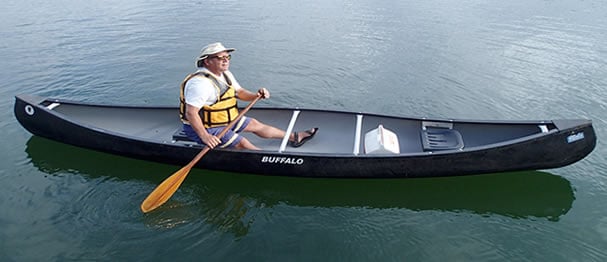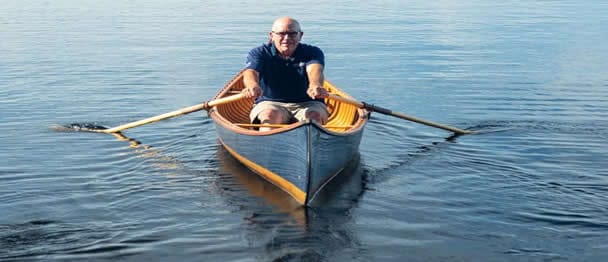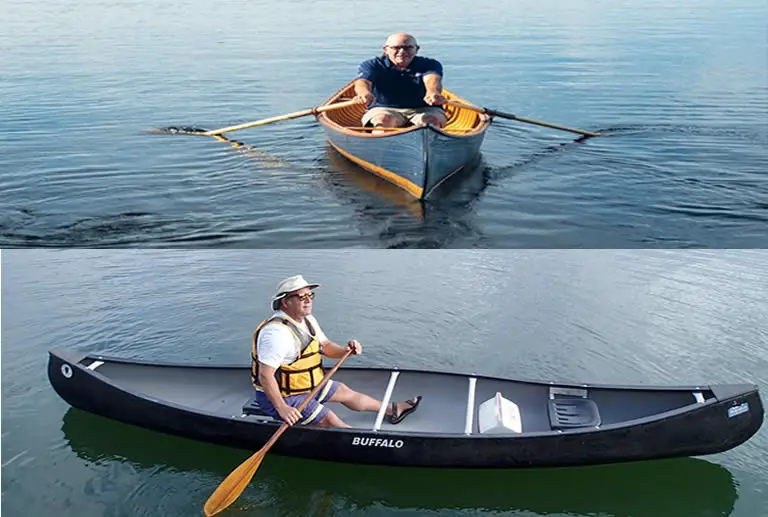Canoes are widely used for water-based recreational activities on inland waterways. You may have seen canoers use paddles to propel their boat. You may have also seen canoers use oars. But what exactly is the best one for a canoeist to use? Here we delve into the oar vs paddle debate.
Contents
Paddle vs Oar – The Great Canoe Debate
Although you may have seen the occasional canoe that has been fitted with a trolling motor, this type of vessel is usually manually propelled.
In this article I delve into the advantages and disadvantages of using both paddles and oars to propel a canoe.
First I will address the most common question asked by new canoeists.
Should a canoeist use a paddle or oars?
Canoes are most commonly propelled and steered with a single-bladed paddle by a person seated facing the direction of travel.
However, canoes can also use oars for propulsion and steering, but the position of the canoeist will be opposite to the direction in which the canoe is moving i.e. the canoeist has their back to the front of the boat.
Some modifications must be made to a canoe before oars can be fitted and used, i.e. you must fit oarlocks to the canoe.
Why Canoeists Most Often Use Paddles
Canoeists mainly use paddles to propel and direct their boats.
As defined in our article about canoes, a canoe is traditionally propelled by a single-bladed paddle wielded by a person whose seat position is facing a forward direction i.e. the canoeist is facing the direction the canoe is travelling in.
The basics of a canoe paddle and how it differs from a kayak paddle
Canoe paddles differ from kayak paddles. Though a kayak paddle is double-bladed, with one blade at each end of the paddle a canoe paddle has just one blade.

A canoe paddle is also a lot shorter in length than a kayak paddle. A canoe paddle also has a grip at the end.
A paddle is held by the paddler using both hands with on hand on the grip and one further down the shaft.
Why canoeists use paddles
It should be noted that paddling a canoe is not the only way to move the boat. Although an outboard motor can be mounted on a canoe and oars can also be fitted (which we will discuss later), paddles are still the most popular, the most accessible and the easiest way to propel this type of vessel.
Canoes were designed to be propelled by a paddle.
Canoeists mostly use paddles to propel their boat because they are relatively cheap and easy to use, especially in shallow waters.
One advantage of using a paddle is its familiar use in other canoeing activities.
Whether you are using your canoe to transport light loads, hunt, fish, perform utility work or engage in recreational activities, paddles are a versatile and great way to steer and propel your boat. They can also be used in just about any marine environment and water condition.
Paddlers control the canoe by using their torso to move and stroke the paddle.
One of the great things of using a paddle to power the canoe is that you are facing forward as you paddle i.e. you are facing the direction you are moving in.
Facing forward when moving forward means that you have total visibility of the area in front of the boat which allows you to direct the canoe easily and react quickly to situations as they arise.
How a canoeist uses a paddle
Learning to paddle a canoe can be daunting at first. But if practiced in calm waters, this skill can be acquired relatively quickly.
Paddling is the motion of positioning the blade in the water at the side of the canoe and as the paddle gathers water, when the paddler draws it backward, it pushes water towards the back of the boat.
This is a forward stroke that creates the momentum that pushes the canoe forward.

Although there are a few different paddling techniques the forward stroke is the most basic form of paddling that can be easily executed even by a first-time canoer.
Nowadays, canoe paddles are being manufactured in bulk thus driving down their price. Many reasonably-priced wooden and carbon fiber paddles are available online and in physical stores for very reasonable prices.
Canoe Oarlocks Can Also Be Fitted So The Canoe Can Be Rowed
Aside from paddling, another great way of manually propelling a canoe is by rowing it using oars.
While paddles are the preferred method of propulsion for most canoeists it is not uncommon to see a canoe fitted with oars.
A quick look at what canoe oars are
An oar is a long shaft which has a flat blade at one end.
There can be different lengths of oars ranging from 6 feet to 21 feet. Oars are usually manufactured from aluminum, reinforced plastic or wood.
Once considered to be an expensive extra modification, now adding oars to a canoe is a relatively cheap endeavor.
You can pick up an oar for roughly the same price as a canoe paddle – though be aware that you need two of them and also oarlocks (which are also pretty cheap – like these easy to install clamp on ones
).
Unlike a paddle, which is always held by a paddler, the non-bladed end of the oar is directly attached to a side of a canoe via an oarlock.

An oarlock keeps the canoe oar in a fixed position while the canoe is being rowed but also allows for free movement of the canoe oar so it can be lifted out of the water and placed inside the canoe.
To use oars on a canoe the canoeist must fit oarlocks to the boat in the same way they would fit them on a Jon boat.
How oars are used to propel a canoe
Oars are used to push water away from the canoe to create forward momentum in the same way as a paddle. However, there is one huge difference in how the canoeist uses these two manual propulsion methods.
The main difference between using a paddle an using oars is the position of the person operating the boat.
If you use oars to propel the canoe, then you will be seated in a position that is opposite to the direction the boat is moving in. When you use canoe oars, you are basically rowing backwards, and from your position in the boat it will appear as though you are traveling in a backward motion.
Rowing is much more powerful than paddling and creates much greater momentum. Rowing is a movement where stroking power is generated from the legs, back muscles, shoulders and biceps.
This makes pulling a more efficient movement than pushing the canoe.
Where a paddle using a pushing movement to move the canoe forward, oars using a pulling movement to move the boat forward.
With rowing, the user is less fatigued as more energy and power is given to the oars than is given to a paddle. Consequently, the canoe travels a greater distance forward with every stroke when using oars.
How a canoeist can row effectively with canoe oars
If oars are to be used on a canoe, then there are things to keep in mind if the boat is to be propelled effectively.
Although you can paddle a canoe from anywhere in the boat, near the bow, near the stern or at the center, rowing requires a more central position.
You must be in a seated position in the canoe at a central point in order to use oars. A canoe’s rowing seat position is traditionally just below the gunwales of the boat.
Additionally changes need to be made for rowing to be effective.
If a canoe is to be used for rowing, the seat should be as near to the center of the boat as possible and it must be adjusted so it sits at a lower level from its original position. This allows the rower’s hands to be properly aligned with their stomach when performing a stroke or row.
This lower seating position also makes for a lower center of gravity on the canoe, hence offering more stability for the rower and the boat.
While a canoe’s rowing seat should be “fixed,” the rower still has to determine the appropriate position based on their height. The link below gives instructions for doing this.
Another thing to consider when contemplating the use of canoe oars for a canoe is where to position the oars and oarlocks. Oarlocks are there to support the oars.
Oarlocks are an essential part of all rowing boats and a canoe that is to be setup for owing is no exception. These are used to attach the oars to the canoe.
Oarlocks are best attached to the outer sides of the canoe at the gunwales of the boat. By positioning them in this way, the canoe oars will not hit the sides of the canoe when the canoeist is rowing.
These are just some of the basics of using oars for a canoe. Here are some detailed specifications and technical instructions for both the positioning of the seat and the oarlocks on a canoe.
Recap: The Oar vs Paddle Debate Is Over
There are obvious differences in performance when using either a paddle or oars. There are also different advantages offered by both.
A major advantage to using a paddle on a canoe is the paddler’s position on the boat. Paddlers maintain a forward-facing direction on the canoe when using a paddle. This gives excellent visibility to the paddler as they can see in the direction the boat is moving in.
A rower faces the opposite direction of the boat when using oars. A rower’s back is facing the direction of movement and therefore they cannot see what is in front of the canoe without looking over their shoulder.
Another advantage of using a paddle is its versatility. Paddles can be used for many canoeing activities like hunting, fishing, transportation, utility work or for recreation purposes.
A paddle is usually held by a paddler when propelling the canoe while oars are attached to the boat using oarlocks.
A canoeist commonly uses a paddle, but a canoe can also use oars for propulsion if the canoeist knows how to make some basic adjustments to the boat – such as attaching oarlocks.
Although using a paddle offers many advantages, so too do oars have their own advantages.
Rowing is the movement where stroking power is generated from the legs, back muscles, shoulders and biceps. This means the canoe is moved via a pulling movement whereas paddling involves pushing the canoe. As bigger, more powerful muscles are used in the pulling movement it should come as no surprise that using oars generates much more power and therefore moves the canoe father and faster with each stroke than using a paddle can do.
With rowing, the user is also less fatigued as more energy and power are generated to the oars with less effort. Consequently, the canoe travels farther forward with every stroke for less energy expended.
The main differences between using oars vs paddles are:
- The seating direction of the paddler and rower are opposite.
- The amount of energy used by the canoeist is greater when paddling than rowing.
While oars can be set up on a canoe, paddles are still the most common way to propel this type of vessel. Though it should be noted here that an outboard motor can also be mounted on a canoe.
Oars and paddles both work well on a canoe.
Whether or not you choose to use a paddle or intend to install oarlocks and use oars for your canoe is totally dependent on how these types of propulsion methods are going to affect your chosen canoe activities and your style of boating.

